|
The Setup—a Photo Essay
During the setup of the Proscenium system, I spent
quite a lot of time photographing the steps that Lloyd and Fred took in
assembling the parts and pieces. It was a truly fascinating process. Since most
of our readers have never seen the level of turntable design execution
represented by the Walker Audio system, I'll share those images with you. It
will give you a sense of the meticulous attention to detail that goes into the
Proscenium.
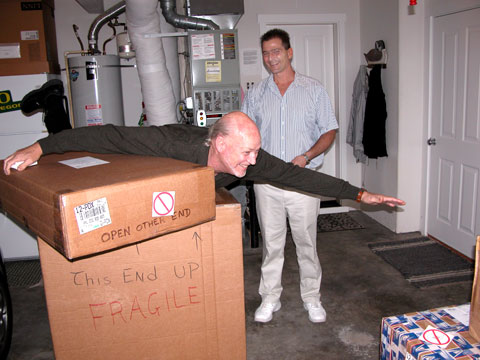
Lloyd Walker does that surfin' thang of his, as
he and Fred Law (rear) prepare to unpack the Proscenium system. You can tell
that neither of them have any fun at all when they work!
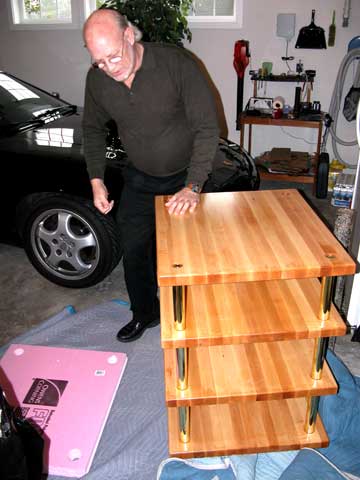
Lloyd inspects the Walker Prologue Rack after
unpacking it in the PFO River City garage. Its construction
is a special configuration of solid maple, with coated solid brass legs that are
filled with lead shot. It stands upon a set of brass Walker Audio Valid Points.
I can tell you that the Prologue Rack alone is a heavy-duty piece of work …but
this was just the beginning of "heavy-duty." There was a lot more to come.
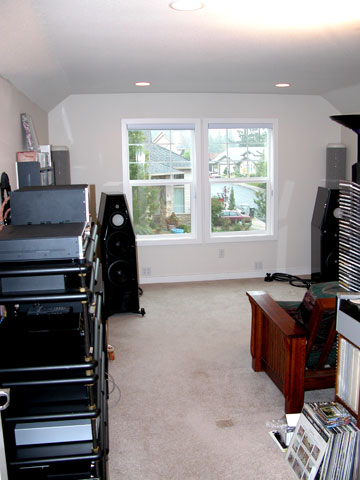
The target space in my listening room, cleared
and waiting for the Proscenium to arrive. At the time, I was using the Kharma
Grande Ceramique speakers and the darTZeel NHB-108 stereo amplifier (unbalanced
mode). To this we would add the Linn Kontrol reference preamp as a line pre for
the Proscenium source, since we segmented the SACD/CD sources (with their EMM
Labs Switchman 3 preamp) from the Proscenium. Going from one to the other would
entail unplugging one set of RCAs and plugging in the other …a real purist
approach to source switching!

Meanwhile, back at the ranch, Lloyd and Fred
unpacked some smaller parts and pieces…

…and unpacked, and unpacked.

Lloyd Walker installs Valid Points on the
Prologue Rack in the listening room. Don't drop one of these solid brass gems on
your foot; you'd have to visit the doctor pretty quickly!
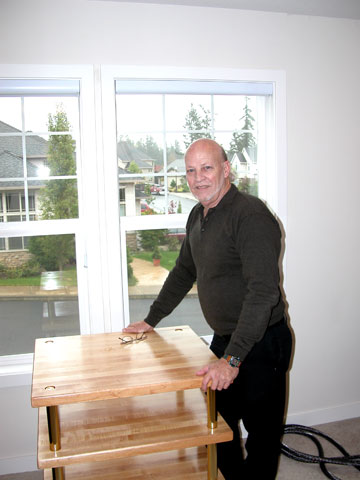
Lloyd with the Prologue Rack, preparing to level
the platform.

Fred and Lloyd are meticulous in their work, at
every step of the process. The Prologue Rack was placed and centered carefully,
then double-checked for proper level. They've done this many times, all over the
world; I was struck by the fact that they obviously had the procedure down pat.
Me, I just ran the camera and chuckled at the jokes, stories and teasing that
were constant while they worked. These gents really get along with each other,
and they're funny as heck!
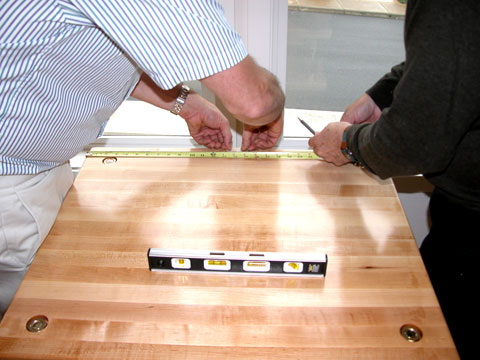
Getting the placement of the rack exactly
right …I did say "meticulous," right? Can I add "precise"?
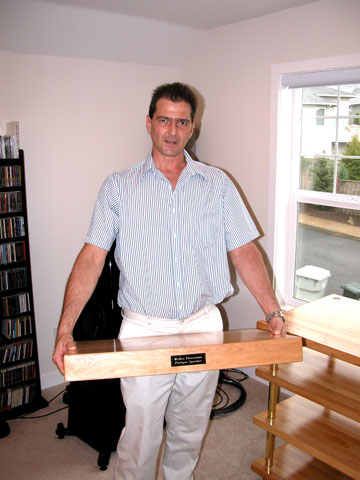
Once the Prologue Rack was correctly placed and
leveled, Fred brought up the Prologue Stand for the Proscenium.
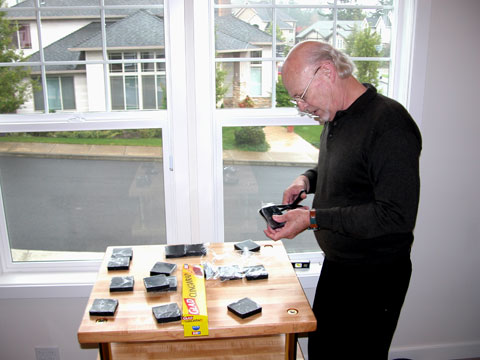
Before the Prologue Stand could be placed on the
Prologue Rack, Lloyd wrapped and placed 16 (!) Sorbothane pads on top. These
decouple the stand from the rack, while still providing very solid support for
the stand and for the Proscenium system that will rest on it.
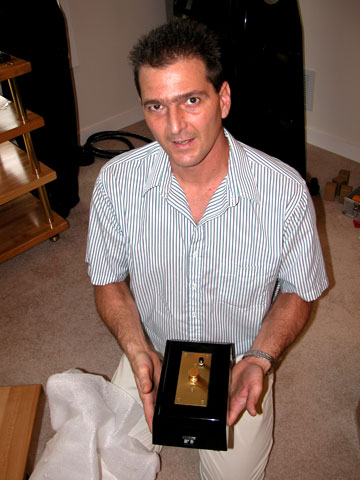
While Lloyd worked, Fred unpacked the motor drive
for the silk belt used to power the platter of the Proscenium.
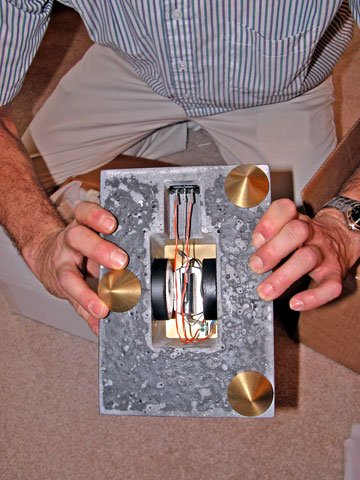
The underside of the motor drive assembly,
showing its three brass Valid Points, as well as the point-to-point wiring. The
chassis is composed of cast crushed marble, coated on top with an attractive
black finish. The motor drive rests in turn on a dedicated isolation platform
with adjustable transit, to control the tension to the drive belt. I'd not seen
anything like this in turntable drive motors.
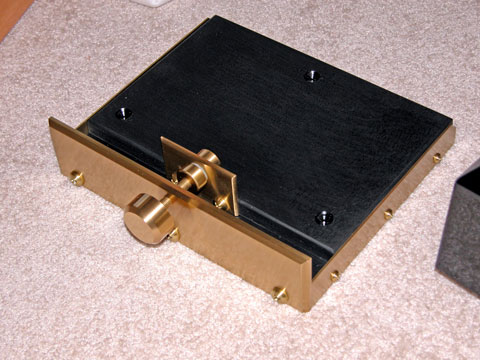
This is the dedicated platform for the
Proscenium's drive motor. The coated brass knob adjusts the distance between the
motor and the turntable. The three insets in the platform are for the three
Valid Points on the bottom of the drive motor (see previous photo). Solid brass
and coated lead…everything in the system was massive, following Lloyd and
Fred's design philosophy of mass-loading the foundation of the platter and
plinth. Frankly, I had never seen anything quite like it.
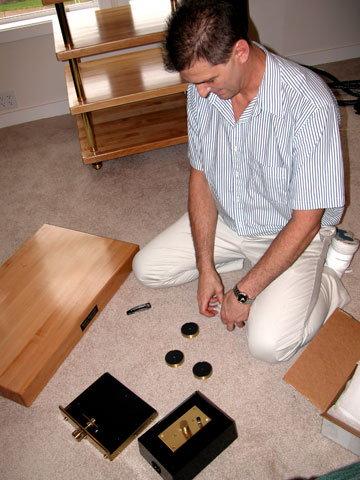
Fred Law prepares to place the motor drive on the
motor drive isolation platform, which will in turn rest on the Prologue Stand—all that to rest on their Sorbothane pods on the Prologue Rack. Isolation and
mass, in spades!
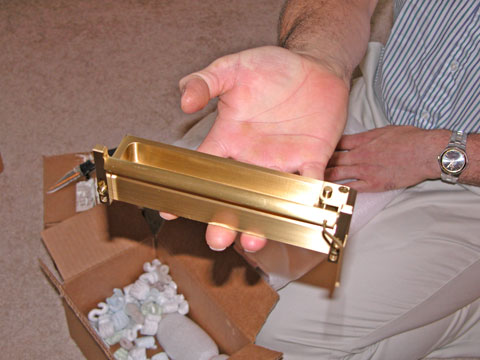
Fred unloads another piece of the puzzle: the
coated brass damping trough with its adjustment knob (to the right) is readied
for placement at the appropriate moment. It will hold a load of synthetic oil
for damping excess vibrations from the stylus/tonearm.
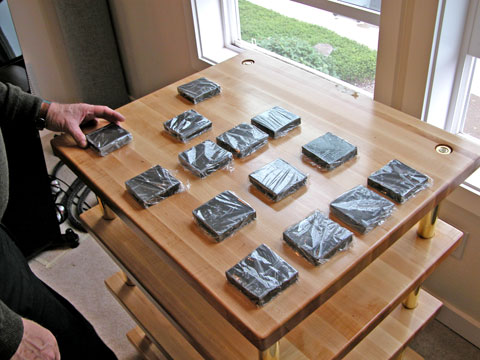
Lloyd places Sorbothane squares precisely for the
load that they are about to receive.
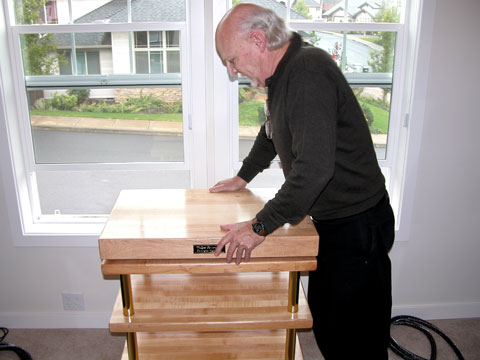
Once the Sorbothane was placed to his
satisfaction, Lloyd put the Prologue stand into position on the Prologue Rack.
This will be the foundation for the rest of the Proscenium system.
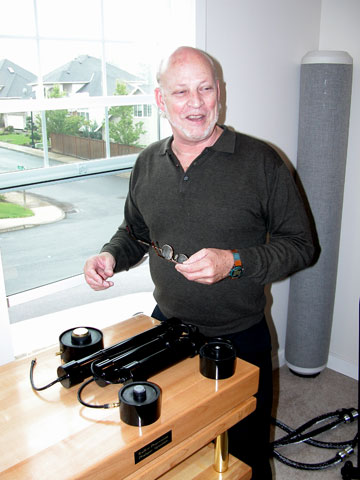
The first component that Lloyd put on the
Prologue Stand was the air pod suspension system. This is used to "float" the
Proscenium on a 45 PSI air suspension, further decoupling it from vibration
during operation.

Lloyd connecting the air pressure pipes to the
suspension pods. Note the air chambers—these are a few of many—designed to
stabilize air pressure and control condensation in the system. The emerging
sophistication of Walker Audio's approach was amazing.
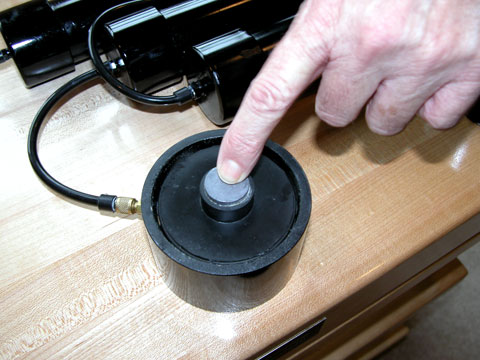
One of the three suspension pod "legs"; when
charged with full pressure, this will float upwards on a chamber of air,
decoupling the turntable yet again from the stand.

Lloyd completing the placement and piping of the
isolation pods.
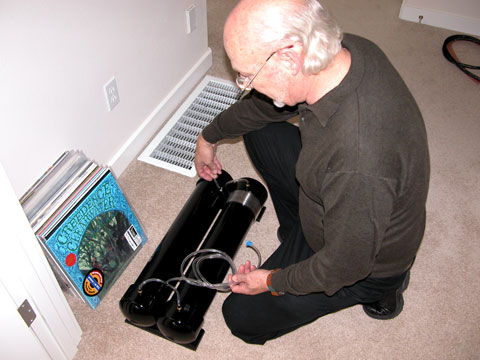
In addition to the air chambers near the
suspension pods themselves, Lloyd had another, larger dual-tank air chamber
system that is placed between the turntable and the air pump. This increases
control of pressure stabilization and humidity in the air lines.
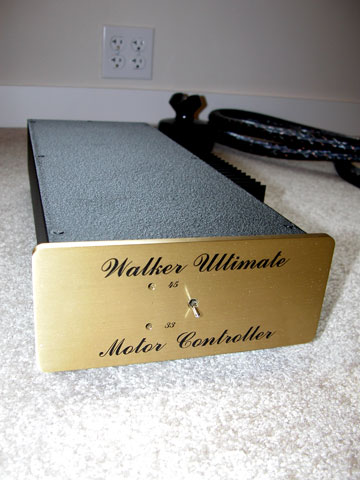
While Lloyd was working on the air pressure
system, Fred continued to unpack other components. Here's the Walker Audio
Ultimate Motor Controller, used to regulate the speed of the turntable.
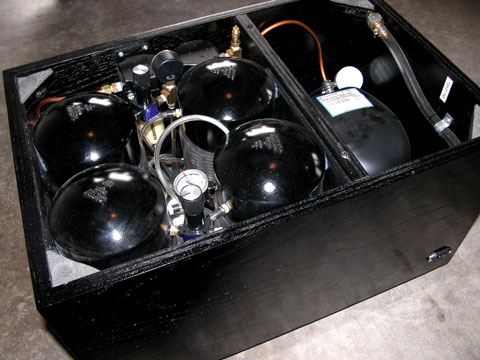
The heart of the Walker Audio air supply system: the air pump system. I had seen air pumps in other turntables (e.g., the SOTA
Millennia, the Forsell), but never anything like this. A 45 PSI heavy-duty pump
(you can see the pressure gauge among the four chambers) with four
pressure/condensation regulation chambers inside, a catch bottle for
condensation/lubricant (this pump uses full synthetic lubricants), more
regulation chambers and lots of copper tubing underneath, and two more
regulation chambers nearby…what's not to like?! The pump measures 23.5" wide x
15" high x 15.5" deep; considerably more than I've seen elsewhere, but highly
compact given its dense contents. A single power switch controls the whole pump
system. There is enough clear plastic tubing to place the pump dozens of feet
from your listening room. We put the pump in my media room, next door to my
listening room, and ran the tubing through a wall vent. The pump runs pretty
quietly when up to pressure (which takes 5-10 minutes), but I think that most
audiophiles would want it in a far corner, a closet, or a nearby room to avoid
any distractions.

This is a close-up of the air pressure gauge
mentioned above. At the time of the photograph, the system was turned off; you
can see that the gauge indicates 0 PSI pressure. The reddish line indicates the
normal operating pressure of 45 PSI, which is maintained spot-on. During a full
year's operation, I never saw any variation in operating pressure at all…the air
pump was solid as a rock, and worked flawlessly.
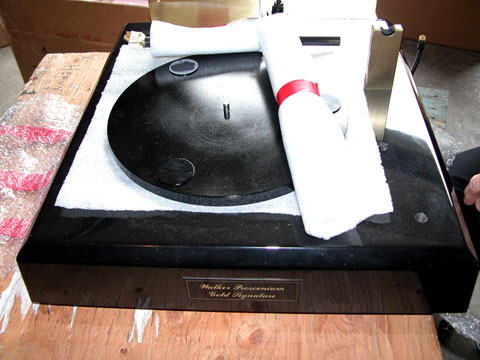
At last! The main chassis of the
Proscenium Gold Reference turntable emerges from its swaddling clothes. The
Proscenium's plinth is composed of an amalgam of lead, crushed marble, and
epoxy, and is bloody inert. IN-ERT. Friends, this is a massive piece of
work: the turntable chassis and platter weight in at about 245 pounds. Solid,
Jackson.

The air chamber system for the linear tracking
tonearm on the Proscenium Gold Signature turntable can be seen clearly here,
fresh from unpacking. The 100% carbon fiber linear tracking tonearm can be seen
with the pure silver leads for the cartridge projecting from the base. The 45
PSI of the air chamber floats the tonearm and cartridge with great authority,
and keeps dust and contaminants at bay.
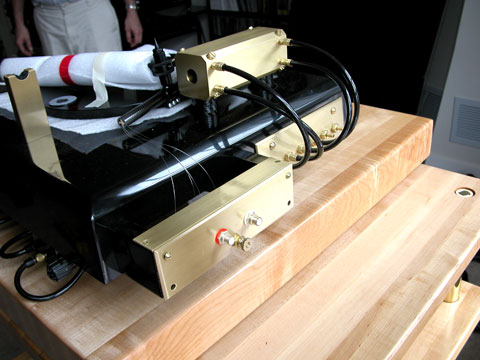
A view of the rear of the Proscenium turntable,
showing the air chamber tubing to the right.
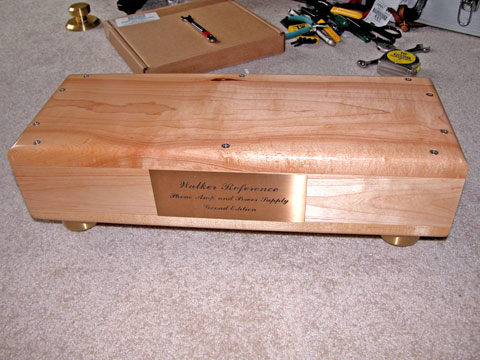
The Walker Reference Phono Amp and Power Supply,
Second Edition. This provides true dual-mono, point-to-point wired power to the
Walker Reference Phono Amp, Second Edition.
Page 3
|































